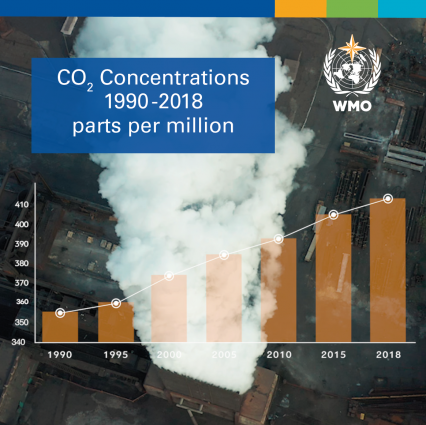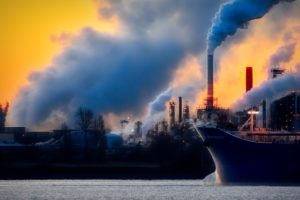Climate change - New UN report warns GHG levels have hit new record high
- November 26, 2019
- Posted by: administrator
- Category: Environmental, Global, Arctic & Antarctica, Europe

According to a new report from the World Meteorological Organization, levels of heat-trapping greenhouse gases in the atmosphere have reached another new record high.
The WMO Greenhouse Gas Bulletin shows that globally averaged concentrations of carbon dioxide (CO2) reached 407.8 parts per million in 2018, up from 405.5 parts per million (ppm) in 2017.
The increase in CO2 from 2017 to 2018 was very close to that observed from 2016 to 2017 and just above the average over the last decade. Global levels of CO2 crossed the symbolic and significant 400 parts per million benchmark in 2015.
The last time the Earth experienced a comparable concentration of CO2 was 3-5 million years ago. Back then, the temperature was 2-3°C warmer and sea level was 10-20 meters higher than now – the UK Environment Agency is currently preparing for a 4°C rise in global temperature
The UN is warning that the continuing long-term trend means that future generations will be confronted with increasingly severe impacts of climate change, including rising temperatures, more extreme weather, water stress, sea level rise and disruption to marine and land ecosystems.
CO2 remains in atmosphere for centuries and in the oceans for even longer
Concentrations of methane and nitrous oxide also surged by higher amounts than during the past decade, according to observations from the Global Atmosphere Watch network which includes stations in the remote Arctic, mountain areas and tropical islands.WMO monitoring tech
Commenting on the new findings, WMO Secretary-General Petteri Taalas warned:
“There is no sign of a slowdown, let alone a decline, in greenhouse gases concentration in the atmosphere despite all the commitments under the Paris Agreement on Climate Change.”
“We need to translate the commitments into action and increase the level of ambition for the sake of the future welfare of mankind.”
“It is worth recalling that the last time the Earth experienced a comparable concentration of CO2 was 3-5 million years ago. Back then, the temperature was 2-3°C warmer, sea level was 10-20 meters higher than now.”
Emissions gap – on current trajectory global emissions not estimated to peak by 2030, let alone 2020
The WMO Greenhouse Gas Bulletin says that global emissions are not estimated to peak by 2030, let alone by 2020, if current climate policies and ambition levels of the Nationally Determined Contributions (NDCs) are maintained. Preliminary findings from the Emissions Gap Report 2019 indicate that greenhouse gas emissions continued to rise in 2018, according to an advanced chapter of the Emissions Gap Report released as part of a United in Science synthesis for the UN Secretary-General’s Climate Action Summit in September.
The United in Science report, which brought together major partner organizations in the domain of global climate change research, underlined the glaring – and growing – gap between agreed targets to tackle global warming and the actual reality.
Stark choice: act now or face consequences of planet “radically altered by climate change”
Inger Andersen, Executive Director of the UN Environment Programme (UNEP) commented:
“The findings of WMO’s Greenhouse Gas Bulletin and UNEP’s Emissions Gap Report point us in a clear direction – in this critical period, the world must deliver concrete, stepped-up action on emissions.”
She went on to warn that the world is now facing a stark choice: to set in motion the radical transformations we need now, or “face the consequences of a planet radically altered by climate change.”
Key Findings of the Greenhouse Gas Bulletin
The bulletin reveals that there are “multiple indications” that the increase in the atmospheric levels of CO2 are related to fossil fuel combustion.
Key Findings of the Greenhouse Gas Bulletin include:
- Carbon dioxide is the main long-lived greenhouse gas in the atmosphere related to human activities. Its concentration reached new highs in 2018 of 407.8 ppm, or 147% of pre-industrial level in 1750.
- The increase in CO2 is also getting bigger and faster every year – the increase from 2017 to 2018 was above the average growth rate over the last decade.
- The growth rate of CO2 averaged over three consecutive decades (1985–1995, 1995–2005 and 2005–2015) increased from 1.42 ppm/yr to 1.86 ppm/yr and to 2.06 ppm/yr with the highest annual growth rates observed during El Niño events.
- The National Oceanic and Atmospheric Administration (NOAA) Annual Greenhouse Gas Index shows that from 1990 to 2018 radiative forcing by long-lived greenhouse gases (LLGHGs) increased by 43%, with CO2 accounting for about 80% of this increase
- Atmospheric methane reached a new high of about 1869 parts per billion (ppb) in 2018 and is now 259% of the pre-industrial level. For CH4, the increase from 2017 to 2018 was higher than both that observed from 2016 to 2017 and the average over the last decade.
- Nitrous oxide (N2O) atmospheric concentration in 2018 was 331.1 parts per billion. This is 123% of pre-industrial levels. The increase from 2017 to 2018 was also higher than that observed from 2016 to 2017 and the average growth rate over the past 10 years.
- Globally averaged concentrations of carbon dioxide (CO2) reached 407.8 parts per million in 2018, up from 405.5 parts per million (ppm) in 2017
In September the Intergovernmental Panel on Climate Change warned that “no place on earth” would be spared from the impacts of climate change in its special report The Ocean and Cryosphere in a Changing Climate
According to the IPPC, we will only be able to keep global warming to well below 2°C above pre-industrial levels if we effect “unprecedented transitions” in all aspects of society, including energy, land and ecosystems, urban and infrastructure as well as industry.
A separate and complementary Emissions Gap Report by UN Environment will be released on 26 November.
Now in its tenth year, the Emissions Gap report assesses the latest scientific studies on current and estimated future greenhouse gas emissions; they compare these with the emission levels permissible for the world to progress on a least-cost pathway to achieve the goals of the Paris Agreement. This difference between “where we are likely to be and where we need to be” is known as the emissions gap.
This will now be taken forward by the UN Climate Change Conference, which will be held from 2 to15 December in Madrid, Spain, under the presidency of Chile.
Click here to access the WMO Greenhouse Gas Bulletin
